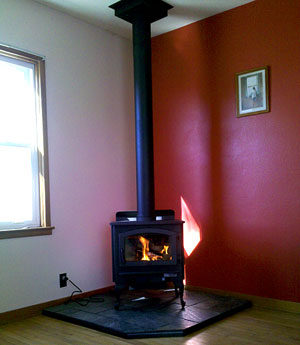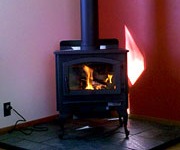 I hearth my stove. Photos: Steph LarsenA lot of my energy this year has been dedicated to pursuits of food, and while normally I dread winter, this year I welcomed cold weather because it meant taking a rest from tending the garden. Our farm provides more than nutrition, though. We also have the land to thank for the toasty living room I now enjoy.
I hearth my stove. Photos: Steph LarsenA lot of my energy this year has been dedicated to pursuits of food, and while normally I dread winter, this year I welcomed cold weather because it meant taking a rest from tending the garden. Our farm provides more than nutrition, though. We also have the land to thank for the toasty living room I now enjoy.
Our decision to install an efficient wood stove was probably sealed last winter when an ice storm knocked out our electricity for four days and with it, our heat. Although our furnace burns propane, the fan that circulates warm air is electric, and unlike our neighbors, we had yet to buy a gas-powered generator. Thankfully it wasn’t terribly cold, and the houseguest we had that weekend had a wonderful sense of humor about our situation.
There are lots of good wood stoves out there, and we asked my dad for brand suggestions because he’s been burning wood my whole life. We settled on a Lopi, though in hindsight we should have also looked at side- and top-loading fireboxes because our stove with its small capacity is hard to pack full. We picked a non-catalytic model because we didn’t want to have to replace the catalytic combuster. Our stove is “75%-plus” efficient because it recirculates particulates to be burned before they go up the chimney. Our first floor is only about 1,000 square feet, so we picked the smallest model, as Umbra suggests.
Because we don’t have a fireplace, we didn’t even look into the possibility of a fireplace insert, which pushes heat into your house that would otherwise go straight up the chimney. Inserts vary widely from simply enclosing the fire with a metal and glass front (not efficient) to putting what amounts to a wood stove inside your existing fireplace (very efficient). The insert version of my stove has nearly the exact same specs as the stove itself.
 My partner has turned into a woodchuck. Photo: Steph LarsenWith the stove installed, we look at the grove that surrounds our house in a different light — not only as a wind block and habitat for hawks, opossum and a flock of red-headed woodpeckers, but as fuel to heat our house. There was a surprising amount of wood already on the ground, some of it evidently drying for years. When our neighbor bought an abandoned homestead and bulldozed several acres of trees, he gave us permission to cut wood off the enormous piles. Now, hardly a weekend goes by when we don’t go over with the chainsaw to get a truckload or two.
My partner has turned into a woodchuck. Photo: Steph LarsenWith the stove installed, we look at the grove that surrounds our house in a different light — not only as a wind block and habitat for hawks, opossum and a flock of red-headed woodpeckers, but as fuel to heat our house. There was a surprising amount of wood already on the ground, some of it evidently drying for years. When our neighbor bought an abandoned homestead and bulldozed several acres of trees, he gave us permission to cut wood off the enormous piles. Now, hardly a weekend goes by when we don’t go over with the chainsaw to get a truckload or two.
My college ecology professor would probably laugh, because we’ve gotten pretty good at tree identification by bark. We split most of our wood ourselves, using a gas-powered (but hand-me-down!) splitter, so I can tell you which types split easily and which aren’t worth the space they take up in the bed of the pick-up. Covered wood stacks now dot the space between outbuildings, and between the studs in our garage we’ve managed to stack about 3 cords of split wood to burn this winter.
I’ve also learned a lot about the art of burning wood, though I’m definitely not the expert in my house. Oak and hickory are the gold standards for long burns, pines start fast and burn hot but not very long, walnut leaves a lot of ash. Round, unsplit pieces are good for overnight because they burn slow. Dry wood sounds hollow. If you start your fire too slow or let wood smolder, creosote will form and may lead to chimney fires.
It’s a lot to take in, but for the first time I’m enjoying winter — I can be warm without feeling guilty. As Aldo Leopold wrote in that Midwestern touchstone A Sand County Almanac, “There are two spiritual dangers in not owning a farm. One is the danger of supposing that breakfast comes from the grocery, and the other that heat comes from the furnace.”



